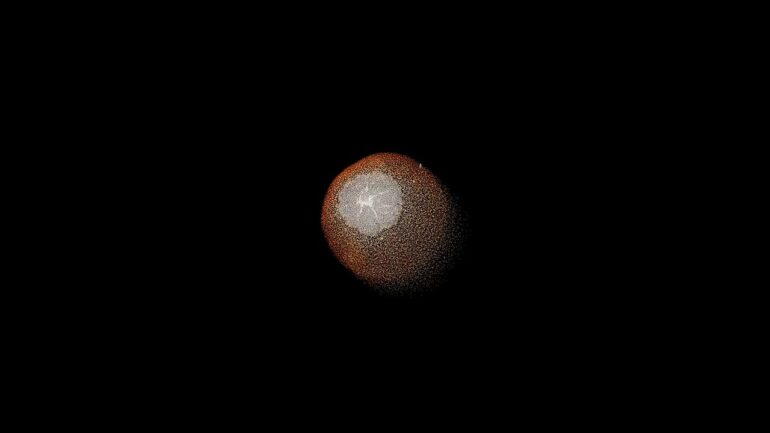On the morning of Feb. 15, 2013, a small asteroid exploded over Chelyabinsk, Russia, sending a loud shockwave and sonic boom across the region, damaging buildings and leaving around 1,200 people injured. The resulting meteor, with a diameter of approximate 20 meters (roughly the size of a six-story building), was one of the largest to be detected breaking up in the Earth’s atmosphere in more than a hundred years.
A decade later, scientists from the Lawrence Livermore National Laboratory (LLNL) Planetary Defense program are releasing details of their research of the airburst event. The team has spent the last three years modeling and simulating the atmospheric breakup of the Chelyabinsk meteor. Their study underscores the important role material strength and fracture played in the breakup dynamics.
Though various research organizations have studied the Chelyabinsk event, LLNL scientists were the first to simulate the Chelyabinsk meteor in full 3D with a material model based on research data from meteorites recovered from the event. Unlike historical meteoric events, the 2013 airburst event was recorded on cell phone and security camera video from multiple angles and a 500-kilogram fragment was recovered from Lake Chebarkul shortly after impact.
Their simulations—which closely matched actual observed events—suggest that the object could have been monolithic, or a single chunk of rock. If this was the case, researchers said, material strength and fracture played a significant role in the object’s breakup and the resulting blast wave.
“This is something that can really only be captured with 3D simulation,” said Jason Pearl, lead researcher on the project. “When you combine LLNL’s specialized expertise in impact physics and hydrocodes with the Lab’s state-of-the-art High Performance Computing capabilities, we were uniquely positioned to model and simulate the meteor in full 3D.
“Our research underlines the importance of using these types of high-fidelity models to understand asteroid airburst events,” Pearl said. “A lot of smaller asteroids are rubble piles, or loosely bound collections of space gravel, so the possibility of a monolith is really interesting.”
The research team used smoothed particle hydrodynamics (SPH), a computational method used for simulating the dynamics of solid mechanics and fluid flows, to examine the breakup mode of a Chelyabinsk-sized monolithic asteroid. In their simulations, the team found that the airburst occurs when major cracks form under tensile stress in the rear of the asteroid. The timescale of crack propagation toward the front of the asteroid controls the time at which the asteroid splits into smaller fragments while entering Earth’s atmosphere. A family of fragments near the shock front then temporarily shields a region of fully-damaged material, until at approximately 30 km above Earth’s surface, the intact fragments separate and the debris is exposed to the free stream. Finally, the debris cloud is rapidly decelerated and the remaining fragments continue breaking up into smaller chunks of rock.
The breakup process is physics-rich, explained LLNL physicist Mike Owen. The coupling of the asteroid to the atmosphere depends on how much surface area it has. The greater the surface area, the more exposure the object has to heat, stress and pressure.
“As the asteroid enters the atmosphere, you start to have sort of a catastrophic failure,” Owen said. “And it tends to compress in the direction of travel. It was like the asteroid was being squeezed in the direction of travel, breaking into distinct pieces that started to separate and break perpendicular to the direction of travel.
“All of a sudden, you’ve got a lot more material being exposed to the hypersonic interaction with the air, a lot more heat being dumped in, a lot more stress on it, which makes it break faster and you get sort of a cascading runaway process.”
A better understanding of the breakup process can be used to build better statistical models of the risk posed by asteroids in the Chelyabinsk-size class. Understanding how these objects break up and transfer their energy into the atmosphere is crucial in providing a good estimate of the damage they may cause and can be used to better inform civil-defense strategies, said LLNL’s Cody Raskin, a key contributor to the project.
A long-term goal of this research would be to use these models to assess the ground effects of a future meteor event, predicting the region that would potentially be impacted.
“Our ability to detect small asteroids has greatly improved in recent years,” Raskin said. “If we can see a small asteroid approaching Earth in time, we could run our model and inform authorities or the potential risk, similar to a hurricane map. They could then take appropriate protective actions, such as evacuating residents or issuing shelter-in-place orders, ultimately saving lives.”
Meteoric events are natural disasters, and just like any other natural disaster, we can do more to be prepared, Owen said. “They are not high-probability events, but we shouldn’t dismiss them as science fiction either.”
Provided by
Lawrence Livermore National Laboratory
Citation:
High-fidelity simulation offers insight into 2013 Chelyabinsk meteor (2023, March 9)



